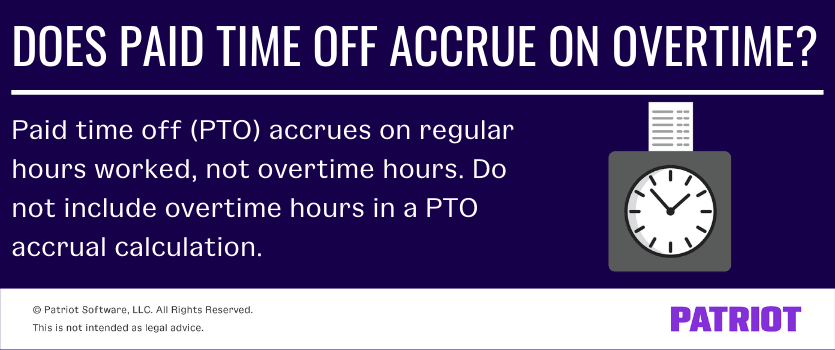Having employees comes with rules from the government. Federal and state laws both provide regulations regarding overtime. And, some states require employers to provide some form of paid time off (PTO). So, how do you calculate PTO, especially if an employee earns overtime? And, does PTO accrue on overtime? Keep reading to find out the answers to these questions and more.
Does PTO accrue on overtime?
So, does PTO count toward overtime? When it comes to PTO accrual, do not include overtime hours in your accrual calculations. Instead, employees accrue paid time off on regular hours worked, up to 40 hours per week.
Separately track the regular and overtime hours your employees work so they do not accrue more PTO than they should.
In most states, overtime begins once an employee works more than 40 hours per week. But, some states have more specific laws regarding overtime (and we’ll get to that later).

What is overtime?
Overtime, also called time and a half, is the rate of pay an employee earns when working over 40 hours in a workweek. Any hour over 40 is overtime. Pay 1.5 times a nonexempt employee’s regular pay rate for each hour over 40.
For example, an employee who works 40 hours per week for $10.00 per hour would receive $15.00 per hour (10 X 1.5) for every hour they work past 40 hours.
What is a nonexempt employee?
Nonexempt employees are those who meet at least one of the following:
- Receives hourly wages
- Earns below the exempt threshold of $684 per week ($35,568 annually)
- Does not have executive, administrative, or professional job duties
You must pay an employee overtime wages if they meet at least one requirement to be classified as nonexempt. A nonexempt employee is typically paid hourly, but you may have salaried nonexempt employees as well.
States with different overtime laws
Again, most states require overtime pay for hours worked over 40 in a workweek. However, four states have state overtime laws requiring overtime pay based on hours worked in a single day:
- Alaska: More than 40 hours in a workweek or more than eight hours in a day
- California: More than 40 hours in a workweek, more than eight hours in a day, or more than six days in a workweek
- Colorado: More than 40 hours in a workweek, more than 12 hours in a workday, or 12 consecutive hours without regard to the starting and ending times of the workday
- Nevada: Eight hours in a 24-hour period if the employee makes less than one and one-half times the minimum wage per hour (unless the employee agreed to work four, 10-hour shifts)
Other states (e.g., New York) have laws that require overtime pay even for some FLSA-exempt individuals. Check with your state for more information regarding overtime laws and accrual.
What is PTO?
PTO is paid time off, which includes time such as:
- Vacation time
- Sick leave
- Personal time
- Holiday leave
- Jury duty
- Bereavement leave
- Any combination of the above
Some employers prefer to roll all paid leave they offer into one and call it PTO. Employers may choose to give their employees a lump sum amount of PTO at the beginning of the year or another designated time (e.g., the employee’s anniversary). However, employers can choose to let their employees’ PTO time accrue throughout the year.
How to determine the amount of PTO
Again, employers can give PTO as a lump sum or let the time off accrue during the year.
| Looking for an easy way to calculate PTO accruals or add time off to an employee? Patriot’s online payroll software integrates seamlessly with our time and attendance add-on so you can track hours, add PTO time, and pay your employees under one login. Start your free 30-day trial today! |
How do you give a lump sum of PTO?
With lump-sum PTO time, employers must decide when to divvy up the entirety of the PTO time. The lump-sum method is also known as frontloading. You may choose to give all employees their PTO time at once or on a set date per individual employee.
Examples of when to give a lump sum include:
- January 1
- The first day of your fiscal year (e.g., July 1)
- An employee’s anniversary date
When giving a lump sum, you preload the employee’s time off account with the entirety of their PTO for the whole year.
For example, you give an employee 15 days of PTO each year on their anniversary. Employee A’s anniversary is April 1. So on April 1, you add 15 days of PTO to their time off account for the employee to use until the following March 31.
How does PTO accrue?
Unlike lump-sum PTO, an employee earns a set amount of overtime for a specific number of hours worked with the PTO accrual method.
For example, you offer one hour of PTO for every 40 hours worked. If you have biweekly pay periods, your full-time employees accrue two hours every two weeks. So, your full-time employees accrue 52 hours, or 6.5 days, of PTO time per year because there are 52 pay periods in a year [(2 X 26) / 8 = 6.5].
PTO caps
Some states require employers to offer some form of paid time off to employees, such as paid sick leave or paid family leave. But, some states also allow employers to limit the number of hours employees may accrue.
For example, California allows employers to set a cap to the number of hours an employee can accrue so long as the limit is not below the required number of hours. In California, employers must give one hour of paid sick leave for every 30 hours worked. But, employers can limit the use to three days (or 24 hours) per year and the accrual to six days (or 48) hours per year.
PTO and overtime
Again, PTO does not accrue on overtime hours, but PTO does play a role in overtime. PTO is paid time for hours employees do not work. So, does PTO count towards overtime? The FLSA does not require employers to include paid time for unworked hours in overtime calculations.
For example, Employee A uses eight hours of PTO on Monday, works eight hours per day Tuesday through Thursday, and works nine hours on Friday. The employee worked 33 hours [(8 X 3) + 9 = 33], and had eight hours of PTO for a total of 41 hours (33 + 8 = 41).
Because eight of the 41 hours were PTO, do not calculate overtime for the one hour over 40 hours on the timesheet. Instead, pay out eight hours of PTO and 33 hours of the employee’s typical rate.
This is not intended as legal advice; for more information, please click here.